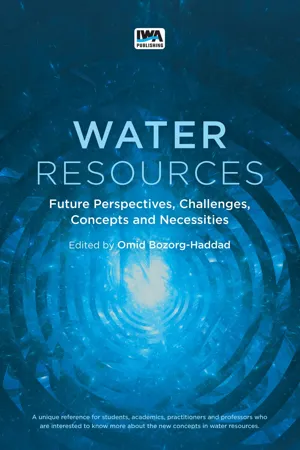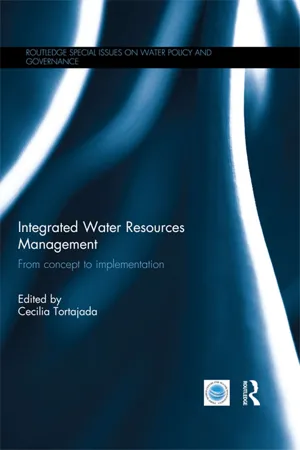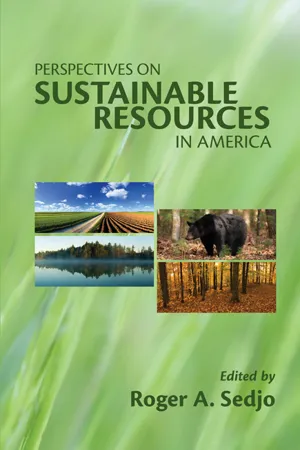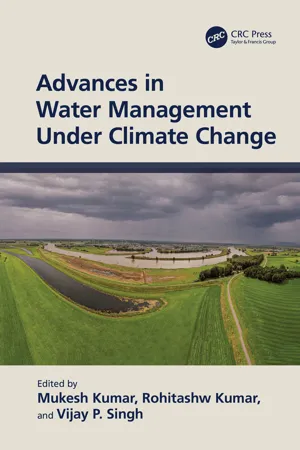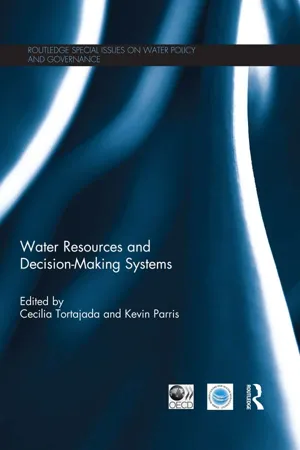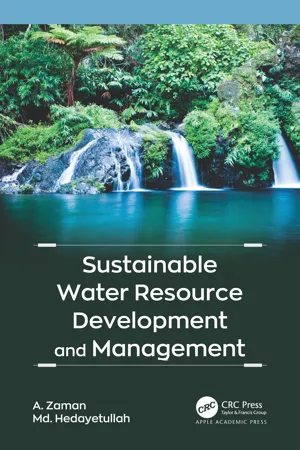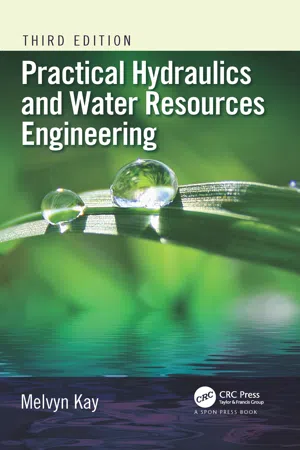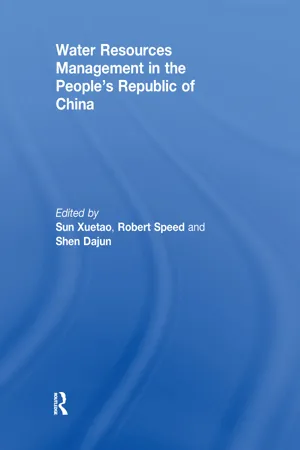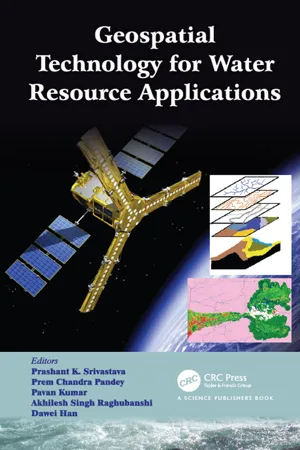Geography
Water Resources Management
Water resources management involves the sustainable and efficient utilization, protection, and allocation of water for various human and environmental needs. It encompasses the planning, development, and maintenance of water infrastructure, as well as the implementation of policies and regulations to ensure equitable access to clean water and the preservation of aquatic ecosystems. Effective water resources management is crucial for addressing water scarcity, pollution, and climate change impacts.
Written by Perlego with AI-assistance
Related key terms
Related key terms
1 of 4
Related key terms
1 of 3
11 Key excerpts on "Water Resources Management"
- Omid Borzog-Haddad(Author)
- 2021(Publication Date)
- IWA Publishing(Publisher)
In the context of Water Resources Management, ‘geographical community’ refers to the use of hydrological boundaries (river basin and sub-basins) to define units rather than political or administrative boundaries. Geographically, Water Resources Management should be undertaken at least on a ‘basin’ scale. In other words, the river basin should be managed as a ‘hydrological unit’ with a single identity. In deciding the development and management of natural resources, this geographical community includes interactions between land and water users in the aquatic and terrestrial ecosystems, and in human systems, as well as upstream–downstream effects within and between the main basin and sub-basins.Similarly, ‘integrity of water use’ refers to the competition for water between agriculture, hydroelectricity, urban water supply and health, industry, and environment. By contrast, economic, social, and environmental integrity refers not only to the costs and economic benefits of water management decisions but also to the costs and benefits of social and environmental considerations, and must be taken into account in any decision making.7.3.5 Implementation of CWRMHuman life is under increasing pressure. In many parts of the world, natural resources have been declining and these problems can no longer be resolved by mere engineering solutions. An integrated approach is needed to coordinate development across sectors, and individuals as well as institutions must contribute to improve conditions. The concept of comprehensive water management has emerged to guide the process that leads to the development and management of more sustainable water resources. These are the ultimate goals of CWRM:(1)to increase economic efficiency to understand the economic and social values of water for people; (2)to achieve equality between different regions and peoples; (3)to achieve environmental sustainability, especially in critical ecosystems.These goals require balancing water consumption at a subsistence level and protecting this resource to sustain its functions and properties. Excessive exploitation and mismanagement can lead to unstable conditions that have severe effects on humans and the environment. This requires that all stakeholders agree on the problems they are involved in and are eager to work together to solve them. Another principle of comprehensive water management emphasizes that the development and management of water resources must be based on a participatory approach and involve all consumers, planners, and policymakers at all levels. The role of women should also be taken into consideration, as women always play a key role in foresight, management, and conservation of water resources at the home level.- eBook - ePub
Integrated Water Resources Management
From concept to implementation
- Cecilia Tortajada(Author)
- 2017(Publication Date)
- Routledge(Publisher)
Nevertheless, water is not the only sector that has these properties. In fact, innumerable other sectors cross-cut and overlap with other sectors and have both vertical and horizontal integration needs. Integrated approaches are very important within these sectors, too, and they have thus developed their specific approaches to systematize and promote integrated management. Examples include the health, natural resources management and coastal zone management sectors and their respective integrative approaches: health in all policies; integrated natural resources management; and integrated coastal zone management (Keskinen, 2010; Stucki, 2011).Various agencies and scholars have presented definitions of IWRM. One of the most commonly used is from the Global Water Partnership (GWP, 2000), for whom IWRM is:a process which promotes the coordinated development and management of water, land and related resources in order to maximise economic and social welfare in an equitable manner without compromising the sustainability of vital ecosystems and the environment.The World Water Council (2000) define it as aphilosophy that holds that water must be viewed from a holistic perspective, both in its natural state and in balancing competing demands on it – agricultural, industrial and environmental. Management of water resources and services need to reflect the interaction between these different demands, and so must be coordinated within and across sectors. If the many crosscutting requirements are met, and if there can be horizontal and vertical integration within the management framework for water resources and services, a more equitable, efficient, and sustainable regime will emerge.Accordingly, waters should be used to provide economic well-being to people, without compromising social equity or environmental sustainability. This should happen in a basin-wide context, with stakeholder participation and under the prevalence of good governance (Keskinen, 2010; Varis & Keskinen, 2006; Varis, Keskinen, & Kummu, 2008; Figure 1). In this way, IWRM can be seen to aim at enhancing good governance and promoting balanced development in relation to social equity, economic growth and environmental sustainability (largely according to the philosophy of sustainable development, which is commonly defined through the triple bottom line as social, economic and environmental sustainability). While all these objectives are naturally very relevant and important, achieving such a balance is typically challenging due to the inherently political nature of decision and planning processes. The political nature is naturally connected to the feature that the three E’ - eBook - ePub
Hydrogeology
Principles and Practice
- Kevin M. Hiscock, Victor F. Bense(Authors)
- 2021(Publication Date)
- Wiley-Blackwell(Publisher)
2009 ).Water Resources Management has a clear and rapidly developing association with many other policy areas such as energy, land use and nature conservation. In this context, groundwater is part of an emerging integrated Water Resources Management approach that recognizes society's views, reshapes planning processes, co‐ordinates land and Water Resources Management, recognizes water quantity and quality linkages, manages surface water and groundwater resources conjunctively and protects and restores natural systems while considering climate change.To achieve a sustainable groundwater system, in which abstraction can continue safely, water resources managers should adopt the definition of safe yield as the maximum prolonged pumping that meets all logistic, environmental, legal, socio‐economic and physical constraints (Gorelick and Zheng 2015 ). It is essential that there is a complete understanding of the future hydrogeologic system so that policies are set now that determine abstraction rates that can achieve the goal of groundwater sustainability through the process of adaptive management (Gleeson et al. 2012 ; Rhode et al. 2017 ). Further, Gleeson et al. (2020 ) considered that purely physically based definitions of groundwater sustainability founded on the concept of safe yield or physical sustainability are too narrow in that they do not include diverse social and environmental aspects. Gleeson et al. (2020 ) suggested a new definition of groundwater sustainability as maintaining long‐term, dynamically stable storage of high‐quality groundwater using inclusive, equitable and long‐term governance and management. This definition implies that part of groundwater natural capital stocks is non‐substitutable, but also allows for significant regional control through equitable governance and management and defining goals, targets and objectives (Gleeson et al. 2020 - eBook - ePub
- Roger A. Professor Sedjo(Author)
- 2010(Publication Date)
- Routledge(Publisher)
CHAPTER 5
Water Resources Management andthe Challenge of Sustainability
Leonard Shabman
WATER IS NEEDED to produce things people value, whether for manufacturing automobiles, growing lettuce and strawberries, ensuring greener lawns and full swimming pools, or for automated dishwashing to save time and improve household sanitation.1 And water provides for more than material comforts. In art, music, and literature, water in the landscape is a symbol of pleasure and inspiration. Water is the focus of even the least wild places—Japanese gardens and Las Vegas hotel fountains. Rivers, lakes, and reservoirs behind dams are at the center of many recreation experiences. To secure all these uses of water, significant public and private investments have been made to control and manage the flows of water in rivers and lakes and into estuaries. Dams create reservoirs that store rainfall and snowmelt from wet times to provide water during dry times. Pipelines and canals move water over long distances. Wells are drilled and water is pumped to the surface and used in homes and on farms.Water availability and the adequacy of the nation's water supply infrastructure to serve those many uses is a long standing national concern (Select Committee 1961;Wollman and Bonem 1971; U.S. WRC 1978; U.S. GAO 1982). Recently, Congress requested a review of “the future of water availability for the nation [because] water is vital to the needs of growing communities, agriculture, energy production, and critical ecosystems” (USGS 2002; Barlow et al. 2004). The Executive Office of the President (Subcommittee on Water Availability and Quality 2004) and the U.S. Department of the Interior (2005) recently issued reports on future water availability. A report from the National Research Council (2001c, v) concludes,In this new century, the United States will be challenged to provide sufficient quantities of high-quality water to its growing population. Water is a limiting resource for human well-being and social development, and projections of population growth as well as changing social values suggest that demands for this resource will increase significantly. These projections have fueled concerns among the public and water resources professionals alike about the adequacy of future water supplies, the sustainability and restoration of aquatic ecosystems, and the viability of our current water resource research programs and our institutional and physical water resource infrastructures. - Mukesh Kumar, Rohitashw Kumar, Vijay P. Singh(Authors)
- 2023(Publication Date)
- CRC Press(Publisher)
1 Water Resource Management An Approach to Sustainable Water Management Ananya Mishra and Rohitashw KumarDOI: 10.1201/9781003351672-11.1 INTRODUCTION
Water is the most important and sustainable natural reserve, which is in serious distress due to its increasing demand though supply decreases. The requirement and demand for water have increased dramatically in cities as a result of increased industrialization, globalization, urban growth, and other such phenomena, which has been exacerbated by the increased population water demand resulting in various types of wastes and sewerages water. Governments and scientists have recognized the value of maximizing of various resource use while minimizing waste and losses. The available water resources in saline oceans contain 97 per cent of the world's water. Two-thirds of the remaining 3 per cent have deposited as ice masses in the polar region and in the form of ice in the mountains. As a corollary, fresh running water accounts for 1 per cent of the Earth's water, of which 98 per cent is groundwater (Jafari et al., 2018a). In a global sense, India's water supply outlook owns just 4 per cent of the world's water supplies while housing 16 per cent of the global population, meaning India's per capita water available is very limited. The amount of accessible water here is approximately 6 trillion m3 , which is the world's highest for a nation of equivalent extent (Jafari et al., 2018a). Water exists in the oceans, atmosphere, between the soil, and fragments of the Earth crust. Renewable radiation drives the movement of water as it transmits between the lithosphere and the environment via evaporation and precipitation. However, owing to wastage and inadequate water conservation schemes, as well as uneven rainfall distribution, a significant portion of the world suffers from water shortages during the year's dry period (Mushtaq et al., 2020). For the past three decades, there has been an increase in water erosion. Not only has the rate and severity of water erosion increased but also the area of water erosion areas, and as a result of increased flooding. In about an area of 125 million hectares of watersheds (62 per cent of the total country), water erosion has been higher than the natural rate, and sedimentation has also increased (Jafari et al.- eBook - ePub
- Cecilia Tortajada, Kevin Parris(Authors)
- 2016(Publication Date)
- Routledge(Publisher)
Challenges for Integrated Water Resources Management: How Do We Provide the Knowledge to Support Truly Integrated Thinking? RACHAEL A. MCDONNELL Oxford University Centre for Water Research, Oxford, UKABSTRACTThe ideas of good governance through integrated Water Resources Management (IWRM) are predicated on bringing together our understanding of water from many domains, thus the provision of knowledge and information is an important part of any enabling environment. Strategies put forward so far have been based on developing systems to integrate existing data from many sources then using different analytical methods such as Environmental Impact Assessment (EIA) to determine the effects of particular policies or management strategies on various water subsystems. This paper reviews some of the challenges associated with such approaches, ranging from the practical problems of data provision to the more fundamental ones associated with adopting such a positivist, techno-scientific framework. It becomes obvious that new approaches are needed which take on board important research findings emanating from fields such as social theory and geographical information science (GIScience).The Context
Ideas for linking our understanding of engineering and the natural science of water to the social, cultural and political context of an area have been muted for over 70 years, but the notion of IWRM became firmly entrenched in discussions on policy and water use during the last 15 years. The need to integrate has gained increasing credence as the interconnectedness of the many domains of Water Resources Management was appreciated (Braga, 2001; Jonch-Clausen & Fugl, 2001). Interactions and feedback from the natural or human environments have compromised water management projects in many areas of the world. - A. Zaman, Md. Hedayetullah(Authors)
- 2022(Publication Date)
- Apple Academic Press(Publisher)
CHAPTER 1 Water Resource DevelopmentABSTRACT
Water is a vital need for sustaining the soil health and supporting life, and the agricultural sector is a major stakeholder of water resources. Despite the fact that over two-third of the earth’s surface is spread with water, currently about 450 million individuals in 29 countries face water shortage and at least 20% of additional water would be required to satisfy the entire water demand for extra 3 billion population by 2025. Because of the fact that among the entire available water, about 97.5% of water is not usable, because of its salinity from the ocean and 2.49% is ice, and only 0.01% is technologically offered and economically accessible water either in different surfaces or in well water sources for human use as well as water in watercourse, lake, and water bodies. Water is running out because of indiscriminate use, especially in agriculture and other uses. Water resources stand one in all the main crises and a threat of dire consequences ensuing from economic condition, hunger, eco-system destruction, soil health condition changes fastening along different severe world issues. Hence, the agricultural water management should be adequately addressed with integrated approach where conservation and transfer of water with higher economic values be obtained along with environmental advantages. Agriculture under rainfed condition is also associated with primarily conservational land treatments to visualize erosion and land degradation must also to be considered as integral part of water resource development and management.1.1 INTRODUCTION
India, with a population of over a billion, has the world’s largest democracy; traditionally, civilization in India, for the most part, is established around water bodies, as most human activities in agriculture and industries depend upon water . The water scenario in India appears to be going from bad to worse. Not only is there a growing scarcity of water within the country but the agriculturally vital states like Punjab, Haryana, Tamil Nadu, and Rajasthan also face a fall in groundwater levels. Although the per capita convenience of available water in India in 1951 was 3500 m3 , in 1999, it fell to 1250 m3 . This is in line with the Ministry of Water Resources, which predicts a decrease to 662 m3- eBook - ePub
People and Environment
A Global Approach
- Gareth Jones(Author)
- 2014(Publication Date)
- Routledge(Publisher)
5 Environmental (mis)management of fresh water Water is the sovereign wealth of a state and its people. It is nourishment; it is fertilizer; it is power; it is transport. Brunhes, 1920 Mismanagement of water has occurred almost since humans became settled agriculturalists and water management policies became focused on short-term solutions and not long-term sustainable solutions. This chapter examines how, in spite of the abundance of water on Earth, we have mis-treated a free resource, resulting in water shortages and a lowering of the quality of supply. A number of case studies are used to show how management of water is central to the economy of a region. The chapter ends by examining a strategy for sustainable water management. 5.1 Introduction How unfortunate that the quotation from Brunhes (1920) with which this chapter opens has been all but forgotten by society over the years since it was written. The ways in which we have mismanaged our fresh water supplies has led to the current predicament of increasing shortages, a lowering of quality and an increase in cost of fresh water that is occurring throughout the world. In the past, society neglected the value of their water supply at their peril and the once great civilization of Mesopotamia that flourished circa 4000 BC (Sears, 1972: 132) and the Inca civilization between AD 1440–1534 (Chepstow-Lusty et al., 1998) are thought to have failed because the agricultural systems fell into decline due to a breakdown in the irrigation system. The early failures to manage the water supply were, undoubtedly, disastrous for the relatively small numbers of people dependent on them. By comparison, the implications of the current challenge to provide a sustainable, safe water supply is several magnitudes greater and is of concern to approximately two-thirds of the world population – some four billion people living in almost every part of the world - Melvyn Kay(Author)
- 2017(Publication Date)
- CRC Press(Publisher)
Chapter 9Water resources planning and management
9.1 THE WATER CHALLENGE
Water is an integral part of everyone’s daily lives, yet each of us values it in very different ways. In the UK and other rich countries, we very much take water for granted. It is well managed, and planning and investment have greatly reduced the risks of water shortages and damage from flooding. We turn on the tap and water flows. We flush toilets and away it goes to be cleaned up. We enjoy the aquatic environment of rivers, lakes and wetlands, which add to the beauty of the landscape and provide us with leisure and pleasure activities.Most people have little idea of the vast amount of water we use to maintain our life style. But this is beginning to change. We have seen how flooding causes misery when homes and businesses are badly damaged. In the UK, in 2011 and 2012, we saw how drought threatened water supplies to our homes and can limit the water available for basic hygiene. It raised public awareness about keeping our rivers clean, and concerns grew over agricultural and industrial wastes which, if left untreated, can pollute our water resources.In the developing countries, people are much more aware of water in their daily lives. Water resources are often scarce. They are not well developed and severe shortages are commonplace, as much from the inadequacies of the water supply systems and poor management as from a lack of water. Wastewater from households and industry flow untreated into rivers, polluting freshwater (Figure 9.1 ). Floods and droughts are a normal way of life for many millions of people and thousands have died from their impacts. In some countries, people are so used to being flooded that they have developed housing which they can raise or lower depending on the river levels (Figure 9.2- Xuetao Sun, Robert Speed, Dajun Shen(Authors)
- 2013(Publication Date)
- Routledge(Publisher)
Protecting and restoring the environmental health of China's waterways, and thus protecting the health of its people, must be the highest priority of the country's water managers. For too long, economic development has taken precedence over environmental concerns. It is time for the pendulum to swing the other way. As development continues and the standard of living rises, the population has become more concerned with environmental conditions. At the same time, the pressure for providing high-quality water supplies and sanitation services to cities and rural regions continues to grow.Improving water supplies and river health will require moving from a solid water management framework on paper to results on the ground. This in turn will require greater skills on the part of water managers. More sophisticated approaches to Water Resources Management will demand a workforce that is suitably equipped to develop and implement new policies and systems. This will require a significant investment in building the capacity of water sector employees. Success will also require the understanding and support of the wider community. This in turn will require improvements in the transparency of policy making and a willingness to involve the community in the decision-making process.The many changes that are required to improve water resources will come at a price. Improving environmental protection will require direct and prompt investment, which will have a direct economic cost. Furthermore, greater regulation is likely to have broader economic ramifications, with a loss of competitive advantage in industrial production. In improving management and regulation, it will be essential that pressures do not simply result in pollution and extraction being relocated to other parts of China. The disparity in wealth across the country makes this a real risk. The government, at a national level, needs to recognize the consequences of tighter environmental controls for undeveloped regions and provide alternatives for their future prosperity.At the heart of the issue is, as always, the need for policymakers to strike a balance between economic development and the protection of water resources, so as to maximize the value of existing supplies while ensuring the long-term sustainability of their use. This includes determining how to balance the cost of, and responsibility for, water protection between rich and poor, between upstream and downstream, and between urban and rural areas.- Prashant K. Srivastava, Prem Chandra Pandey, Pavan Kumar, Akhilesh Singh Raghubanshi, Dawei Han(Authors)
- 2016(Publication Date)
- CRC Press(Publisher)
Nationwide survey of water supply and sanitation schemes revealed the poor functionality of drinking water and sanitation schemes. According to the survey, 25.4 percentage are functioning well, 36.1 percentage need minor repairs, 9.2 percentage need major repairs, 19.8 percentage need rehabilitation, 8.6 percentage need reconstruction and 0.9 percentage are non-refunctionable (NMIP/DWSS 2014). Both the growing demand of water for domestic and production uses as well as the water stress issues induced by climate change is emerging as a key challenge for the water sector. Water Resources Act, 1992 of Government of Nepal has set up priorities for water sources based upon their uses with the key priority on drinking water followed by irrigation, hydropower and others. The functionality study conducted by WARM-P in 2011 in 92 gravity water supply schemes of the same region revealed that water yield decreased in 24% (out of 224 in 92 schemes) of the water sources as compared to the yield at the time of construction of schemes. During discussions with community members, as a part of the planning phase in WUMP, a majority of them stated that the primary water sources which they are using for their drinking purposes are drying up and they are forced to look for other sources to meet their water supply demand. Many existing water supply systems are in danger of abandonment due to drying up of their sources or inadequate water at the intake point. The WUMP + 3R approach addresses these issues with a focus on participatory planning of water resources and integration of 3R solutions in the water resources development plan.The integration of GIS application in a 3R based WUMP facilitates the hydrological study of the catchments and helps to identify the critical water resources and associated catchment areas (Thakur. et al. 2012). GIS layers give a clear spatial whereabouts of the existing water resources (Srivastava et al. 2012) combined with various physical environments like catchment, hydrological basins, drainage networks (Singh et al. 2013a), contours, slope, aspect, land-use, available water budget and settlement, which further help to classify zones based on the hardship and future possible water stress zones which may be affected by the impacts of climate change. Consequently, different 3R technologies and other watershed conservation activities can be concentrated for balancing ecosystem services in those identified zones and thus ultimately strengthening the yield from those sources. Thus, it proves to be very beneficial tool in decision making during the planning process, so that either the conservation activities can be better utilized or the project implementers have a better understanding of the future scenarios and critical areas of different catchments prior to planning of the projects. Thus, transforming environmental data to information helps build knowledge to decision support and ultimately to social impact (Avtar et al. 2012; Srivastava et al. 2012). Spatial technologies are crucial not only in mapping water resources, especially water channels in a watershed, but also in land cover/land use change detections for general management of such resources (Nathanail 2013; Kaburi and Odero 2014).
Index pages curate the most relevant extracts from our library of academic textbooks. They’ve been created using an in-house natural language model (NLM), each adding context and meaning to key research topics.
Explore more topic indexes
Explore more topic indexes
1 of 6
Explore more topic indexes
1 of 4
